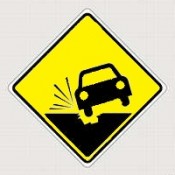Potholes: an unfortunate consequence of winter that wreak havoc on roads and tires across the world. Potholes have existed since the beginning of roads themselves and annually cause destruction, but have you ever wondered how these pesky pits came to exist?
By definition, potholes are deep natural underground cavities formed by the erosion of rock, car traffic, and especially by the action of water. They can grow to be several feet in width and several inches deep. Water creeps under the asphalt of roads as a result of rain, snow, and ice, and weakens the supporting soil of the road. Car traffic then expedites the deteriorating of the road, as it breaks the already weakened road, often causing “crocodile cracking”, or cracking of the road that exists in many small cracks in one area. As vehicles continues to drive over these cracks, chunks of pavement begin to come loose, and the wheels of vehicles can eject these chunks, creating a pothole.
Potholes can be an even larger problem in communities that are prone to freezing and thawing, including Rye Brook. There are four main factors that cause these areas to become victim to potholes. First, the weakening of soil by precipitation. Second, when the water freezes, it expands and creates cracks in the pavement. Third, when spring rolls around and the ice thaws, the water can weaken the soil structure. For this reason, potholes are revealed in the springtime. Lastly, after all of this damage, traffic can break the already fragile pavement.
Some roads are more susceptible to potholes than others. The first main cause of potholes is insufficient thickness of pavement to support the traffic during freeze and thaw periods. The second main cause of pothole formation is insufficient drainage and the third are failures at utility trenches and castings (manhole and drain casings). The last main cause of pothole formation is miscellaneous pavement defects and cracks left unattended and unsealed, which allows for the admittance of more water.
Pothole repair is imperative for preventing car accidents and car injury. Pothole repair falls into two main categories: temporary and semi-permanent. Temporary repair usually involves a cold mix asphalt-patching compound placed quickly to temporarily restore pavement smoothness. Semi-permanent repair, on the other hand, uses more care in reconstructing the area of the pothole to be good as new, and usually uses a hot-mix asphalt fill above the replacement of appropriate base materials.
There are several repair techniques used to repair potholes. One of the methods is called the throw-and-go method, and is the most commonly used method due to its high rate of production. The throw-and-go method involves placing the material into the pothole and ensuring the patch has some crown.
As repairs are unfavorable and costly, prevention of potholes is the most favorable course of action. Potholes can be prevented in four main ways: surveying pavements for risk factors (local roads are at-risk pavement), providing adequate drainage structures, preventative maintenance, and utility cut management. Reporting potholes is also useful, and can be done today through smart phone applications.
Potholes are a top cause of accidents, causing an estimated 100,000 accidents per year. Several people have tried to file a claim against New York State for car damages, however it is not allowed.
Recent developments by British scientists indicate that self-repairing potholes may be a development of the future. This repair technique uses bacteria to plug gaps and cracks opened up by bad weather and can significantly increase asphalt life.
Rye Brook and the general Westchester area contain many potholes. After a bad nor’easter storm this past February, a Westchester service center owner said he saw an estimated 40 cars in his shop. According to a 2013 study by TRIP, a non-profit national research group that studies highway transportation, nearly 51 percent of roads in New York City and the surrounding suburbs are in poor condition, making the region the sixth worst in the nation. The study also estimates that each driver in the country pays an average of $377 in vehicle repairs due to roads with potholes or ones that are in rough condition. In the New York City metro area, drivers spend an estimated $673 each year in vehicle repair due to poor road conditions.







